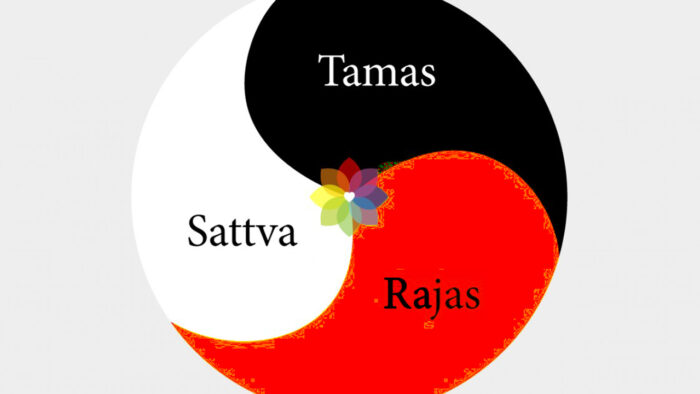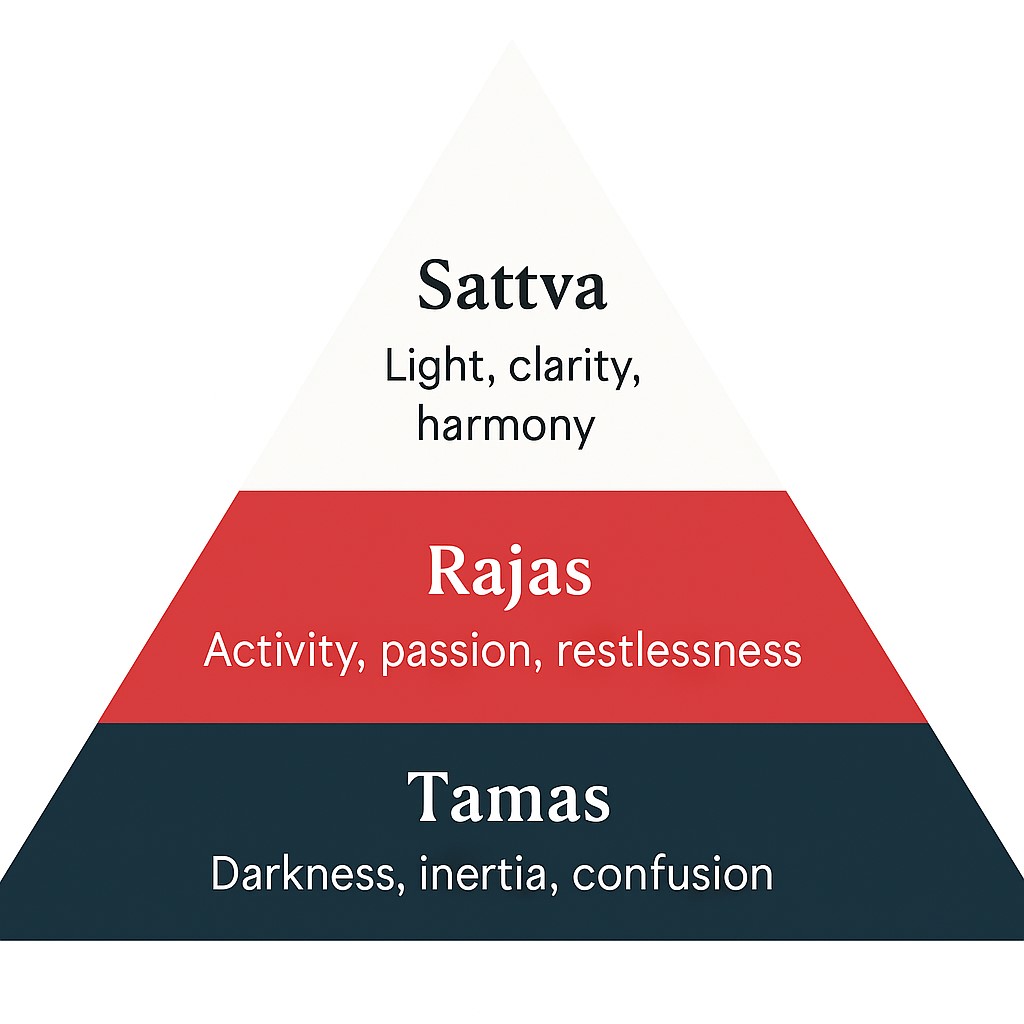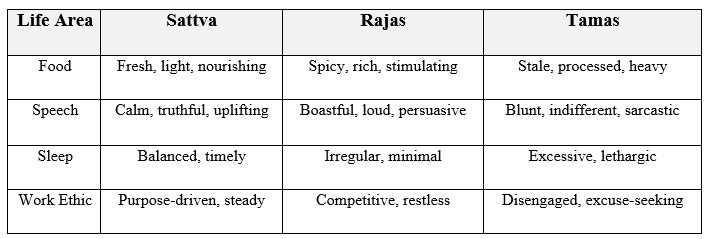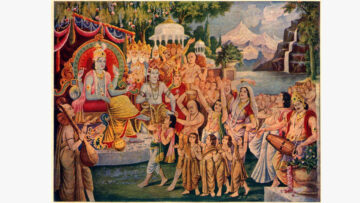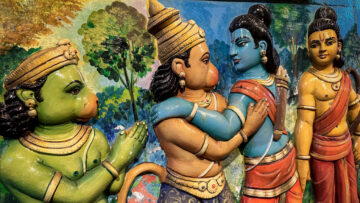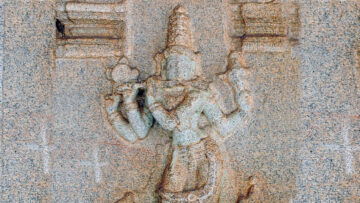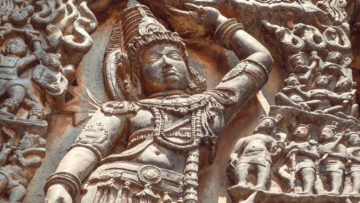A Modern Exploration of Chapter 14 of the Bhagavad Gita
“Each day, we are pulled by subtle energies; one towards calm wisdom, another into restless striving, and a third into dark inertia. To awaken is to learn who is driving.”
Introduction: The Hidden Drivers of Our Decisions
We often believe we are fully in charge of our choices. But beneath the surface of every decision, mood, and habit, something deeper moves us. Why do we sometimes act with grace and calm, and at other times, feel hijacked by impatience, desire, or even numbness? Chapter 14 of the Bhagavad Gita offers an answer; not by blaming fate or others, but by revealing the silent trio of energies within: the three guṇas.
These guṇas are not external forces. They are psychological patterns that color our perceptions, motivations, and behavior. The Gita does not condemn us for being under their influence. Instead, it calls us to become aware and through that awareness, to become free.
सत्त्वं रजस्तम इति गुणाः प्रकृतिसम्भवाः ।
निबध्नन्ति महाबाहो देहे देहिनमव्ययम् ॥BG१४.५॥
Sattvaṁ rajas tama iti guṇāḥ prakṛiti-sambhavāḥ
Nibadhnanti mahā-bāho dehe dehinam avyayam ॥BG 14.5॥
(Sattva, rajas, and tamas are the guṇas born of nature. O mighty-armed Arjuna, they bind the imperishable soul to the body.)
The Guṇas: Sattva, Rajas, Tamas: A Subtle Psychology
The Gita teaches that all of nature; body, mind, and world is governed by three qualities:
- Sattva: Light, clarity, harmony
- Rajas: Activity, passion, restlessness
- Tamas: Darkness, inertia, confusion
These guṇas are like filters placed over our consciousness. When sattva dominates, we feel peaceful and insightful. When rajas rises, we become driven, ambitious, but restless. And when tamas takes over, we feel stuck, sleepy, or avoidant.
In today’s world, these guṇas are not just spiritual concepts; they are living energies shaping how we think, act, and relate. Like invisible lenses, they color our choices without us even realizing it.
Visual Map of the Three Guṇas: The ascending triangle illustrates the energetic movement from tamas (inertia) to rajas (activity) to sattva (clarity)
Sattva: The Quiet Strength of Clarity
When sattva prevails, our actions are thoughtful, our emotions balanced, and our presence soothing to others. It is not inactivity, but calm activity. It brings with it a sense of inner light, joy without cause, and a love for knowledge and goodness.
Think of a wise teacher who responds to chaos with steadiness. Or a colleague who listens more than they speak, and when they speak, offer something constructive. These are everyday signs of sattva in motion; not dramatic, but deeply transformative.
In the Gita, sattva is the path of elevation. But it too binds the soul, says Śhrī Kṛiṣhṇa; binding us through attachment to happiness and knowledge. Even light, when clung to, can become a trap. Hence, the call is not to remain in sattva, but to transcend even that.
तत्र सत्त्वं निर्मलत्वात्प्रकाशकमनामयम् ।
सुखसङ्गेन बध्नाति ज्ञानसङ्गेन चानघ ॥BG१४.६॥
Tatra sattvaṁ nirmalatvāt prakāśakam anāmayam
Sukha-saṅgena badhnāti jñāna-saṅgena cānagha ॥BG14.6॥
(Of these, sattva is pure, illuminating, and free from sickness. It binds the soul by attachment to happiness and knowledge, O sinless one.)
Rajas – The Fire That Fuels and Burns
Rajas is the engine of movement. It fuels ambition, action, and change. It brings passion, desire, competitiveness, and attachment to results. In moderation, it is necessary. But when dominant, it makes us restless, dissatisfied, and ego-driven.
We see rajas in the entrepreneur who never rests, chasing goal after goal. Or the influencer who measures worth in likes and shares. Rajas can make us feel powerful, but it never lets us feel at peace. We are always chasing, never arriving.
In society, rajas builds economies but also burns out people. It drives innovation but also fosters anxiety. The Gita warns: without inner balance, rajas entangles us in cycles of craving and disappointment.
रजो रागात्मकं विद्धि तृष्णासङ्गसमुद्भवम् ।
तन्निबध्नाति कौन्तेय कर्मसङ्गेन देहिनम् ॥BG१४.७॥
Rajo rāgātmakaṁ viddhi tṛiṣhṇā-saṅga-samudbhavam
Tan nibadhnāti kaunteya karma-saṅgena dehinam ॥BG14.7॥
(Know rajas to be full of passion, arising from craving and attachment. It binds the soul through attachment to action, O Arjuna.)
Tamas: When Inertia Masquerades as Comfort
Tamas clouds everything. It is not just lethargy; it is a kind of spiritual numbness. It brings confusion, laziness, procrastination, and often, denial of responsibility. Tamas is what makes us say, “What’s the point?” and do nothing.
Tamas is found in addiction, in endless distraction, in staying in toxic environments because change feels too hard. It can look like comfort, but it is the comfort of stagnation. Left unchecked, tamas can erode not just potential but hope.
The Gita is not harsh here. It treats tamas not as sin but as darkness that can be lifted. With even a small spark of intention or insight, tamas can be pierced and transcended.
तमस्त्वज्ञानजं विद्धि मोहनं सर्वदेहिनाम् ।
प्रमादालस्यनिद्राभिस्तन्निबध्नाति भारत ॥BG१४.८॥
Tamas tv ajñāna-jaṁ viddhi mohanaṁ sarva-dehinām
Pramādālasya-nidrābhiḥ tan nibadhnāti bhārata ॥BG14.8॥
(And tamas, born of ignorance, deludes all beings. It binds through negligence, laziness, and sleep, O Bhārata.)
We Are Not the Guṇas : We Are the Witness
Śhrī Kṛiṣhṇa’s powerful insight in Chapter 14 is this: you are not these guṇas. You are the witness; the consciousness behind them. Like clouds passing across the sky, guṇas change, but the sky remains.
When we begin to observe our moods, our compulsions, our highs, and lows, we create space between them and our true self. This space is awareness. And awareness is the beginning of liberation.
To live wisely is not to never feel rajas or tamas, but to stop identifying with them.
नान्यं गुणेभ्यः कर्तारं यदा द्रष्टानुपश्यति ।
गुणेभ्यश्च परं वेत्ति मद्भावं सोऽधिगच्छति ॥BG१४.१९॥
Nānyaṁ guṇebhyaḥ kartāraṁ yadā draṣṭānupaśyati
Guṇebhyaś ca paraṁ vetti mad-bhāvaṁ so’dhigacchati ॥BG14.19॥
(When the seer perceives no agent of action other than the guṇas and knows Me as beyond them, they attain My divine nature.)
The Path to Guṇātīta: Living Beyond Conditioning
Who is the guṇātīta; the one beyond guṇas?
According to the Gita, it is one who remains steady in joy and sorrow, success and failure, praise, and blame. This person neither hates nor craves, neither exults nor despairs. They live not reactively, but responsively, anchored in inner freedom.
Such a person is not detached in a cold way. They are warm, engaged, and clear; but no longer pulled by the drama of the ego. They act from depth, not from compulsion.
In daily life, such people bring immense stability. They are calm in conflict, simple in power, and humble in success. They are rare and needed.
ऊर्ध्वं गच्छन्ति सत्त्वस्था मध्ये तिष्ठन्ति राजसाः ।
जघन्यगुणवृत्तिस्था अधो गच्छन्ति तामसाः ॥BG१४.१८॥
Ūrdhvaṁ gacchanti sattva-sthā madhye tiṣhṭhanti rājasāḥ
Jaghaṇya-guṇa-vṛitti-sthā adho gacchanti tāmasāḥ ॥BG14.18॥
(Those situated in sattva rise upward; those in rajas remain in the middle; and those in tamas sink downward, acting in base tendencies.)
Yet, even the pursuit of equanimity can feel like effortful striving when attempted through sheer discipline or detachment. Śhrī Kṛiṣhṇa gently opens another door; a path where the heart leads the way. It is through bhakti, devotion born of love and surrender, that one can rise above the pull of guṇas with grace rather than strain. For where awareness brings clarity, devotion brings transformation.
The Supreme Bridge Across the Guṇas
In one of the most compassionate turns of this chapter, Śhrī Kṛiṣhṇa declares that deep devotion transcends all guṇas.
By loving the Divine; not through rituals alone, but through surrender, service, and inner connection; we are lifted beyond conditioning. Bhakti burns rajas with surrender, dissolves tamas with longing, and even releases the clinging of sattva.
This path is accessible to all. Not just scholars or yogis, but anyone with a heart awakened to something higher.
मां च योऽव्यभिचारेण भक्तियोगेन सेवते ।
स गुणान्समतीत्यैतान्ब्रह्मभूयाय कल्पते ॥BG१४.२६॥
Māṁ ca yo’vyabhichāreṇa bhakti-yogena sevate
Sa guṇān samatītyaitān brahma-bhūyāya kalpate ॥BG14.26॥
(Those who engage in unswerving devotion to Me rise above these three guṇas and become fit to attain Brahman.)
The Guṇas in Everyday Life : How to Recognize and Rise
Here is a simple way to reflect on how guṇas play out in daily life:
The goal is not perfection but awareness. Try asking at the end of the day:
“What guṇa influenced most of my choices today?”
Over time, this simple practice rewires our inner life.
सत्त्वात्सञ्जायते ज्ञानं रजसो लोभ एव च ।
प्रमादमोहौ तमसो भवतोऽज्ञानमेव च ॥BG१४.१७॥
Sattvāt sañjāyate jñānaṁ rajaso lobha eva ca
Pramāda-mohau tamaso bhavato’jñānam eva ca ॥BG14.17॥
(From sattva arises wisdom; from rajas, greed; and from tamas arise negligence, delusion, and ignorance.)
Closing Reflection: The Choice is Ongoing, The Awareness is Everything
We are all dancers in the field of the guṇas. Sometimes we rise with light, sometimes race with fire, and sometimes sleep through life. The Gita invites us to become aware, not ashamed. To become awake, not perfect.
The moment we begin to notice the patterns, we begin to outgrow them. The moment we recognize the witness within, we stop reacting and start responding. And the moment we turn inward with devotion, the Divine meets us with grace.
This inner balancing is not abstract. It affects how we parent, how we lead, how we rest, how we love. The guṇas shape not just our mind, but our world.
The path to freedom begins not outside, but within.
For Practitioners: Applying the Wisdom of the Guṇas
If the teachings in this article have resonated with you, consider beginning a simple weekly practice to deepen your awareness of the guṇas in daily life. Here are a few suggestions:
1. Guṇa Journaling (Once a Day or Weekly)
-
- At the end of the day, pause and reflect:
- Which guṇa was most active in my thoughts, choices, and interactions today?
- What triggered it; was it environment, food, company, or mood?
- What small shift can I make tomorrow to invite more clarity (sattva) into my day?
2. Guṇa Observation in Specific Domains
- Choose one area of life each week; such as speech, food, relationships, or work ethic and observe how the guṇas manifest in that domain.
- Record patterns without judgment. Awareness itself brings transformation.
3. Sāttvic Anchors
- Identify 1–2 daily activities that uplift you into sattva (e.g., morning silence, reading sacred texts, mindful eating). Consciously include them in your routine.
4. Bhakti Integration
- If you’re drawn to devotional practice, close each day with a short prayer, offering your actions to the Divine. Bhakti softens rajas and awakens sattva effortlessly.
This practice need not be rigid. Let it be a gentle companion; guiding you not toward perfection, but toward presence.
Notes and References
A. This article is inspired by Chapter 14 of the Bhagavad Gita—Guṇa Traya Vibhāg Yog; and draws upon both classical commentaries and modern interpretations. The insights presented are shaped by the works of esteemed teachers such as Swami Chinmayananda, Swami Sivananda, Paramhansa Yogananda, and others who have illuminated the nature of the three guṇas and their role in inner growth. While adapted for contemporary relevance, the reflections remain grounded in the original Sanskrit verses and uphold the philosophical and ethical essence of the text.
B. Further Reading
1. The Bhagavad Gita – Swami Chinmayananda
A detailed and profound commentary that illuminates how the three guṇas operate in daily life, and how spiritual awareness can lead us beyond their influence.
2. Bhagavad Gita: A New Translation – Eknath Easwaran
Modern, clear, and engaging; this translation makes the concept of guṇas accessible to contemporary readers and offers relatable reflections on their impact in daily experiences.
3. The Essence of the Bhagavad Gita – Explained by Paramhansa Yogananda (as told by Swami Kriyananda)
Offers a deeply yogic view of the inner journey, where sattva, rajas, and tamas are seen as obstacles to the soul’s awakening and devotion is presented as the supreme path.
4. Tattva Bodha – Adi Shankaracharya
A foundational Vedantic primer on the components of the individual and universe, including an essential explanation of guṇas as part of prakṛiti; ideal for readers wanting a philosophical grounding.
5. Three Gunas: The Mirror of Mind – Swami Tejomayananda
A concise and insightful work specifically dedicated to understanding the nature of sattva, rajas, and tamas, and their manifestations in thoughts, behavior, and spiritual evolution.
Feature Image Credit: in.pinterest.com
Disclaimer: The opinions expressed in this article belong to the author. Indic Today is neither responsible nor liable for the accuracy, completeness, suitability, or validity of any information in the article.

